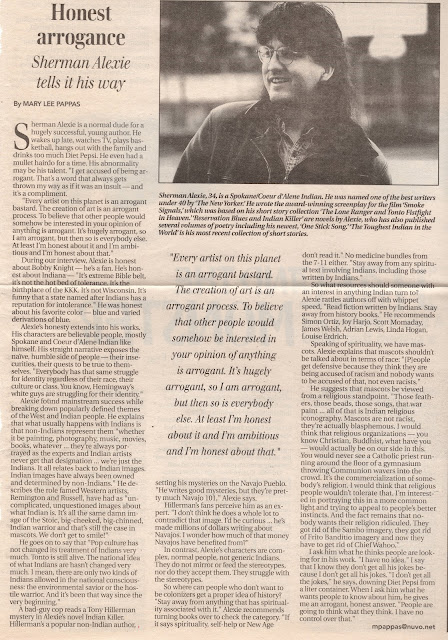Sherman Alexie is a normal dude for a hugely successful, young author. He wakes up late, watches TV, plays basketball, hangs out with the family and drinks too much diet Pepsi. He even had a mullet hairdo for a time. His abnormality may be his talent. “I get accused of being arrogant. That’s a word that always gets thrown in my way as if it was an insult – and it’s a compliment.“
“Every artist on this planet is an arrogant bastard. The creation of art is an arrogant process. To believe that other people would somehow be interested in your opinion of anything is arrogant. It’s hugely arrogant, so I am arrogant, but then so is everybody else. At least I’m honest about it and I’m ambitious and I’m honest about that.“
During our interview, Alexie is honest about Bobby Knight – he’s a fan. He’s honest about Indiana – “It’s extreme Bible Belt. It’s not the hotbed of intolerance. It’s the birthplace of the KKK. It’s not Wisconsin. It’s funny that a state named after Indians has a reputation for intolerance.“ He was honest about his favorite color – blue and varied derivations of blue.
Alexie's honesty extends into his works. His characters are believable people mostly Spokane and Coeur d’Alene Indian like himself. His straight narrative exposes the naïve, humble side of people – their insecurities, their quest to be true to themselves. “Everybody has that same struggle for identity regardless of their race, their culture or class. You know, Hemingway‘s white guys are struggling for their identity.“
Alexie found main stream success while breaking down popularly defined themes of the West and Indian people. He explains that what usually happens with Indians is that non-Indians represent them “whether it be painting, photography, music, movies, books whatever… they’re always portrayed as the experts and Indian artist never get that designation… we’re just the Indians. It all relates back to Indian images. Indian images have always been owned and determined by non-Indians." He describes the role famed Western artist, Remington and Russell, have had as “uncomplicated, unquestion images about what Indian is. It’s all the same damn image of that stoic, big-cheeked, big-chinned, Indian warrior and that’s still the case in mascots. We don’t get to smile!“
He goes on to say that “Pop culture has not changed its treatment of Indians very much. Tonto is still alive. The national idea of what Indians are hasn’t changed very much. I mean, there are only two kinds of Indians allowed in the national consciousness: the environmental savior or the hostile warrior. And it’s been that way since the very beginning."
A bad-guy cop reads a Tony Hillerman mystery in Alexie ‘s novel Indian killer. Hillerman's a popular non-Indian author, setting his mysteries on the Navajo Pueblo. "He writes good mysteries, but they’re pretty much Navajo 101,“ Alexie says.
Hillerman‘s fans perceive him as an expert. “I don’t think he does a whole lot to contradict that image. I’d be curious… he’s made millions of dollars writing about Navajos. I wonder how much of that money Navajos have benefited from?“
In contrast, Alexis‘s characters are complex, normal people, not generic Indians. They do not mirror or feed the stereotypes, nor do they except them. They struggle with the stereotypes.
So where can people who don’t want to be colonizers get a proper idea of history? “Stay away from anything that has spirituality associated with it." Alexie recommends turning books over to check the category. “If it says spirituality, self-help or New Age don’t read it.“ No medicine bundles from the 7-Eleven either. “Stay away from any spiritual text involving Indians, including those written by Indians.“
So what resources should someone with any interest in anything Indian turn to? Alexie rattles authors off with whippet speed, “Read fiction written by Indians. Stay away from history books." He recommends Simon Ortiz, Joy Harjo, Scott Momaday, James Welsh, Adrian Lewis, Linda Hogan, Louis Erdich.
Speaking of spirituality, we have mascots. Alexie explains that mascots shouldn’t be talked about in terms of race: (P)eople get defensive because they think they are being accused of racism and nobody wants to be accused of that, not even racist.“
He suggested mascots be viewed from a religious standpoint. “Those feathers, those beads, those songs, that warpaint… all of that is Indian religious iconography. Mascots are not racist, they’re actually blasphemous. I would think that religious organizations - you know Christian, Buddhist, what have you - would actually be on our side in this. You would never see a Catholic priest running around the floor of the gymnasium throwing Communion wafers into the crowd. It’s the commercialization of somebody’s religion. I would think that religious people wouldn’t tolerate that. I’m interested in portraying this in a more common light and trying to appeal to peoples better instincts. And the fact remains that nobody wants their religion ridiculed. They got rid of the Sambo imagery, they got rid of Frito Bandito imagery and now they have to get rid of Chief Wahoo."
I ask him what he thinks people are looking for in his work. “I have no idea.“ I say that I know they don’t get all of his jokes because I don’t get all of his jokes. “I don’t get all the jokes,“ he says downing Diet Pepsi from a liter container. When I ask him what he wants people to know about him, he gives me an arrogant, honest answer. “People are going to think what they think I have no control over that.“



